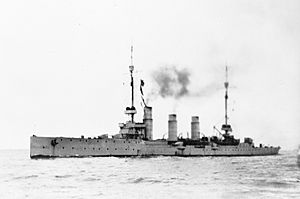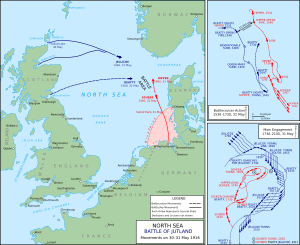SMS Elbing facts for kids

Elbing's sister ship Pillau, c. 1914–16
|
|
Quick facts for kids History |
|
|---|---|
| Name | Elbing |
| Namesake | City of Elbing |
| Builder | Schichau-Werke, Danzig |
| Laid down | 1913 |
| Launched | 21 November 1914 |
| Commissioned | 4 September 1915 |
| Fate | Scuttled at the Battle of Jutland on 1 June 1916 |
| General characteristics | |
| Class and type | Pillau-class light cruiser |
| Displacement |
|
| Length | 135.3 m (444 ft) |
| Beam | 13.6 m (45 ft) |
| Draft | 5.98 m (19.6 ft) |
| Installed power |
|
| Propulsion |
|
| Speed | 27.5 knots (50.9 km/h) |
| Range | 4,300 nmi (8,000 km; 4,900 mi) at 12 kn (22 km/h; 14 mph) |
| Complement |
|
| Armament |
|
| Armor |
|
SMS Elbing was a fast and powerful light cruiser (a type of warship) built for the German Navy. She was originally ordered by the Russian Navy in 1913, but when World War I started, Germany took control of her. She was launched in November 1914 and officially joined the German fleet in September 1915. Elbing had one sister ship, Pillau. She was armed with eight large guns and could travel very quickly.
Elbing took part in two important naval operations during her short time in service. The first was a raid on British coastal towns in April 1916. A month later, she was involved in the huge Battle of Jutland, one of the biggest naval battles in history. During this battle, she was accidentally hit by another German battleship. This caused a lot of damage, leaving her stuck in the water without power. Most of her crew were rescued by a torpedo boat, and the remaining crew sank the ship to prevent it from falling into enemy hands.
Contents
Ship Design and Features
Elbing was about 135.3 m (444 ft) long, which is longer than a football field. She was 13.6 m (45 ft) wide and sat 5.98 m (19.6 ft) deep in the water. When fully loaded, she weighed about 5,252 t (5,169 long tons).
How She Moved
The ship was powered by two large steam turbines. These turbines spun two huge propellers, each about 3.5-meter (11 ft) across. Ten boilers (six coal-fired and four oil-fired) created the steam needed to run the turbines. This powerful system allowed Elbing to reach a top speed of 27.5 knots (50.9 km/h; 31.6 mph), which is very fast for a ship of her size. She could travel about 4,300 nautical miles (8,000 km; 4,900 mi) (around 7,963 km (4,948 mi)) at a slower speed of 12 knots (22 km/h; 14 mph).
Weapons and Crew
Elbing was well-armed for battle. Her main weapons were eight 15 cm (5.9 in) guns, placed in single mounts around the ship. She also had two smaller 8.8 cm (3.5 in) guns for shooting down aircraft. For close-range attacks, she carried two 50 cm (20 in) torpedo tubes. She could also carry 120 mines to lay in the water, which could damage enemy ships.
The ship's crew usually included 21 officers and 421 sailors. To protect the ship, her deck was covered with armor up to 80 mm (3.1 in) thick, and her command center (the conning tower) had 75 mm (3 in) thick sides.
Service History
Elbing was built in Danzig (now Gdańsk, Poland). She was laid down (meaning her construction began) in 1913. When World War I started in August 1914, the German Navy took her over. She was launched in November 1914 and officially joined the German fleet on September 4, 1915.
After joining the fleet, Elbing became part of the II Scouting Group. This group often worked with the I Scouting Group, which included powerful battlecruisers.
Raid on British Coasts
Elbing's first big mission was a raid on the British towns of Yarmouth and Lowestoft on April 24-25, 1916. As the German ships approached Lowestoft, Elbing and another German cruiser, Rostock, spotted a group of British ships. The German commander ordered his battlecruisers to continue bombarding the towns, while Elbing and other light cruisers engaged the British ships.
Around 5:30 AM, the two groups of light ships began firing at each other from a distance. When the German battlecruisers arrived, the British ships quickly retreated. A British cruiser and a destroyer were damaged before the Germans stopped the fight, fearing British submarines in the area.
Battle of Jutland
In May 1916, the German fleet commander, Admiral Reinhard Scheer, planned to draw out and destroy part of the British fleet. Elbing was still with the II Scouting Group for this operation. The German fleet left port on May 31, heading for the Skagerrak waters.
First Shots Fired
Around 3:00 PM, lookouts on Elbing spotted a Danish ship. Elbing sent two torpedo boats to check it out. At the same time, two British cruisers were also heading to inspect the same ship. When the British cruisers saw the German torpedo boats, they opened fire. Elbing quickly joined the fight, firing her guns at 3:32 PM. She scored the very first hit of the entire battle on the British cruiser Galatea, though the shell did not explode. The British ships then turned north, and Elbing continued to fire from a distance. She was joined by two other German cruisers, but they had to stop firing by 4:17 PM as the British ships moved out of range.
About 15 minutes later, the three German cruisers fired at a British seaplane. They didn't hit it, but the plane was forced to land after its engine broke down. The cruisers then returned to their positions ahead of the German battlecruisers.
Engaging the Enemy
Around 6:30 PM, Elbing and the rest of her group met the British cruiser HMS Chester. They opened fire and hit the British ship several times. As the cruisers disengaged, three British battlecruisers arrived. Their lead ship, HMS Invincible, hit a German cruiser, disabling it. Elbing and another German cruiser each fired a torpedo at the British battlecruisers, but both missed. Elbing was briefly fired upon by the battlecruisers but was not hit. Around 8:15 PM, Elbing lost power to one of her engines due to leaks, which slowed her down to 20 kn (37 km/h; 23 mph) for the next four hours.
Night Battle and Collision
Later that night, Elbing was still having engine problems and couldn't keep up with the faster ships. She ended up sailing with the IV Scouting Group. At 11:15 PM, Elbing and Hamburg spotted a British cruiser and several destroyers. They used a British signal to get close, then turned on their searchlights and opened fire. The British cruiser was hit seven times and caught fire, forcing the British ships to turn away. As they turned, they fired torpedoes at Elbing and Hamburg. One torpedo passed under Elbing but didn't explode. While this was happening, another group of British cruisers arrived and joined the fight. Elbing was hit once, which destroyed her radio equipment. Four of her crew were killed and twelve were wounded.
Shortly after midnight, the German fleet ran into a group of British destroyers. Elbing was sailing on the left side of the German line. The lead German battleship, Westfalen, opened fire, followed by Elbing and other ships. The British destroyers launched a torpedo attack, forcing the German cruisers to turn sharply to the right to avoid them. This turn pointed the cruisers directly into the path of their own German battle line.
Elbing tried to pass between two German battleships, Nassau and Posen. However, the captain of Posen didn't realize what was happening until it was too late. Posen turned hard to the right but still crashed into Elbing's back right side. The collision tore a hole below the waterline, flooding her engine rooms. The ship tilted sharply at first, then the water spread, and the tilt lessened. Her engines stopped, and she lost all electrical power. Elbing was completely stuck, but she wasn't in danger of sinking immediately.
Scuttling the Ship
At 2:00 AM, a German torpedo boat, S53, came alongside and took off 477 officers and men from Elbing. Her commander and a small group stayed behind. They tried to use an improvised sail to get the ship closer to shore. But around 3:00 AM, British destroyers were spotted nearby. To prevent the ship from being captured by the enemy, the order was given to sink Elbing herself.
The remaining crew lowered the ship's small boat into the water and left. On their way back to port, they rescued a doctor from a damaged British destroyer. Around 7:00 AM, a Dutch fishing boat found them and took them to Holland.
During the Battle of Jutland, Elbing fired 230 rounds from her main guns and one torpedo. Four of her crew members died, and twelve were injured.


